Are you looking for lawn alternatives for your garden project? A lush, healthy lawn is visually appealing, welcoming, and can add to the value of a home or business. But while grass is the most common choice, it’s not necessarily the best.
Whether you’re tired of mowing the lawn constantly or simply want a different look and feel to your outdoor space, lawn alternatives may be the perfect option for you.
Explore the factors you need to consider before choosing a lawn type and why traditional grass may not be ideal.
More...
Why Use Lawn Alternatives?
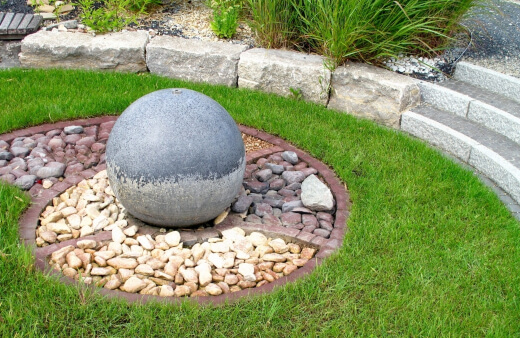
All grass is created equal, right? Wrong; there are multiple types of grass, each with its own benefits and disadvantages. Property owners typically report the following issues with traditional grass:
- Requires consistent maintenance
Grass needs to be mowed every week or two and requires the additional expense of a lawnmower, whipper snipper and fuel. By using lawn alternatives, you save on maintenance cost, just make sure you have a lawn edger ready to help you do the edgings for your lawn. - Requires the addition of chemicals for pest control
Pests love grass. To keep them at bay and protect your loved one outdoors, you need to perform routine pest control treatments. This can harm the environment by killing beneficial insects, as well as being dangerous to children, pets, and wildlife. - Require weed control
Traditional lawns do suffer with weed growth, and that means hours of manually pulling weeds or using herbicides. Herbicides can be dangerous to pets, wildlife, and the environment as they wash into water systems, and they aren’t inexpensive either.
(If you deem it necessary, check out our guide to weed killers to learn its types and how to use them safely in your garden.) - Requires supplemental irrigation
Particularly in dry areas, grass is prone to die during times of drought. Keeping a lush lawn intact during dry seasons will require frequent watering and maybe even installing an irrigation system.
If you’re looking for easier ideas to create a beautiful landscape, you’re in luck. Alternatives to traditional grass lawns are convenient, stunning, and naturally inviting.
Choosing the best lawn for your property requires an evaluation of its purpose, location, and environmental risks. Will the lawn remain relatively undisturbed by traffic, or will it be an area where people play, work, or drive?
Do you have pets and children? Are you interested in native, indigenous alternatives or plants that will work in your climate? Consider your unique needs and local climate before selecting a grass alternative.
Top 10 Lawn Alternatives Australia
1. Native Grasses
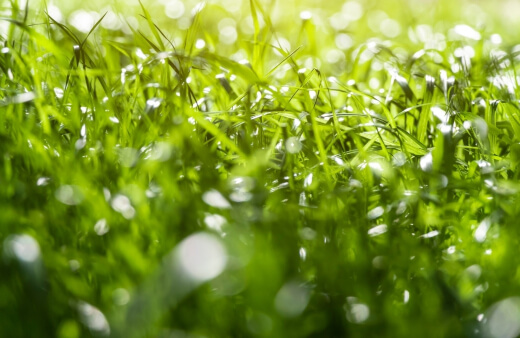
A new way to achieve a beautiful lawn, reduce water consumption, and cut your workload in half all at once is to plant native grasses. They also help support native ecosystems of butterflies, beneficial insects and wildlife, so they’re ideal for an eco-friendly garden.
There are a number of different species suited to different regions and climate, including shade and sunshine varieties. Some of the best native grasses alternatives to use for lawn include:
Weeping Grass (Microlaena stipoides)
This cool-season grass is found in Australia and New Zealand. Although it thrives in wetter zones, it also has a very high drought tolerance. It’s a spreading grass that can be mown to any height, making it a good choice for traditional lawns.
It has a high frost tolerance, moderate salt tolerance, and is shade tolerant too. It is not recommended for heavy traffic areas and has a low dog urine tolerance.
Wallaby Grass (Austrodanthonia)
Another cool-season grass, wallaby grass grows well in Australia’s temperate zones and has a high frost and drought tolerance. It’s a tufted grass that should not be mown lower than 4cm, and can grow to heights of 30-80cm.
It grows easily without irrigation or fertiliser, and are good decorative or pasture grasses rather than lawn grasses.
Kangaroo Grass (Themeda triandra)
Kangaroo grass is one of the most widespread indigenous grasses in Australia, and thrives in all states and territories. It’s a tufted grass that can be mown twice a year but can grow to heights of 40-90cm.


Get Your Free Guide:
Master Growing Australian Natives eBook
A Must Have Complete Guide for Every Australian Garden
Get Your Free Guide:
Master Growing Australian Natives eBook
A Must Have Complete Guide for Every Australian Garden
It is a beautiful decorative grass that changes colour from green to maroon through the seasons, with rusty-red seed heads. It is very drought and heat tolerant, with a low frost tolerance.
Redgrass (Bothriochloa macra)
A second popular warm-season native grass is redgrass, which is a runner so it grows more like a traditional lawn. It reaches heights of 10cm, has a high heat and drought tolerance with a low frost tolerance.
It thrives in coastal, tablelands and slopes environments, and has beautiful green and reddish foliage with reddish-purple flowering stems in the summer and autumn. Because it only reaches heights of 10cm, you may never need to mow it.
2. Blue Star Creeper (Isotoma fluviatilis)
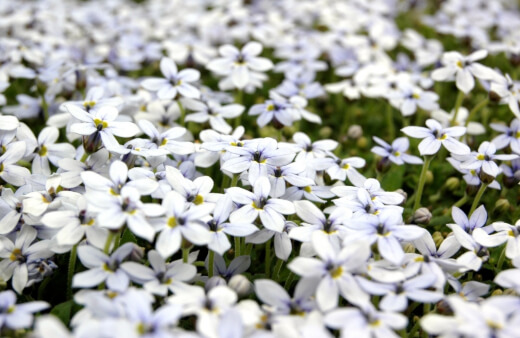
From use as a decorative landscape accent or complete ground covering, Blue Star Creeper grows in light shade or full sun and features charming blooms in hues of blue and white.
Native to Eastern Australia and New Zealand, this perennial is ideal for areas of light foot traffic, and has moderate heat and drought tolerance, although it prefers moist conditions.
This Australian native ground cover lawn substitute is evergreen throughout the year and is effortless to maintain, providing you keep it moist until it is established (about 12 weeks from planting). There are 3 subspecies:
- Isotoma fluviatilis subsp. australis
- Isotoma fluviatilis subsp. borealis
- Isotoma fluviatilis subsp. fluviatilis
This grass alternative grows quickly and makes a bold statement in any landscape, and looks beautiful as a lawn, in rockeries, or around paved areas.
3. Oregano Grass
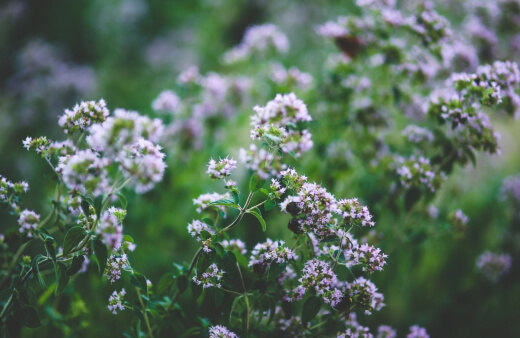
If you are looking for a beautiful, scented and useful lawn alternative, oregano is a great choice. Creeping oregano or oregano grass is a type of groundcover, and comes in multiple forms, with creeping oregano (Origanum vulgare ‘Humile’), creeping golden marjoram (Origanum vulgare ‘Aureum’) and mounding marjoram (Origanum majorana) performing very well.
It grows well in sun or partial shade, including around trees and rockeries. It’s soft to walk on, tolerates light to moderate foot traffic, and is very low maintenance. You can either mow it in the very early spring to create a neater lawn for the summer
that’s the only time it needs mowing), or leave it for a wilder, more natural look. Most varieties produce pretty flowers through the summer, attracting bees and butterflies.
Unlike traditional grass, this fully-edible ground cover requires little watering or fertilising, and has plenty of texture, making it an ideal accent for a detailed landscape or ground covering for an open field.
4. Elfin Thyme (Thymus serpyllum ‘Elfin’)
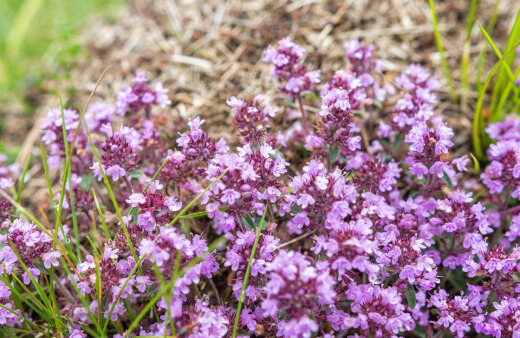
Also known as creeping thyme, elfin thyme is studded with vivid lavender and pink flowers through the summer, resistant to drought damage and has multiple uses, such as a full ground cover or stepping stone accent.
Like the oregano grass, it’s fully edible and has a wonderful, lemony scent! It grows to a height of 5cm in sunny or partial shade, so you don’t need to mow it unless you want to neaten it up (best done after the flowering season is over).
Despite its delicate appearance, it tolerates traffic from kids and pets, and it’s well-suited to the Australian climate. Because this grass alternatives need adequate drainage, it’s ideal for dry or exposed slopes, sandy soil, rockeries, well-drained lawns, and footpaths.
5. Rock
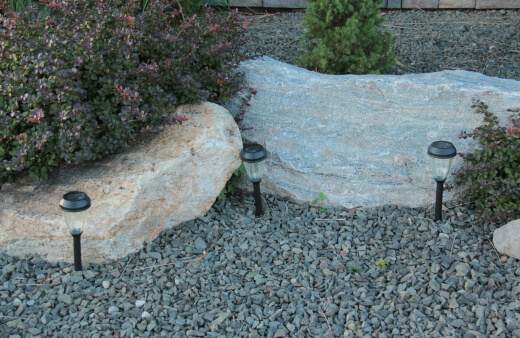
Whether you plan to cover a large portion of your lawn or simply want to accent a landscape’s focal points, rock is a cost-effective solution requiring virtually no maintenance. Rocks also provide shade and shelter for native insects and wildlife, so they are a very eco-friendly option for green gardening.
Choose strategic locations in which to feature rock groupings, like those where irrigation or maintenance is not ideal, or where the ground is too exposed or heavily shaded for lawn. You can also use glow stones for added beauty when night comes check out the best glow stone here.
Gravel is a great lawn alternative that stands up to heavy traffic although it is not child or playground-friendly. It can be used to create striking outdoor spaces when paired with larger rocks and native plants, or when used on driveways or pathways.
6. Chamomile Lawn
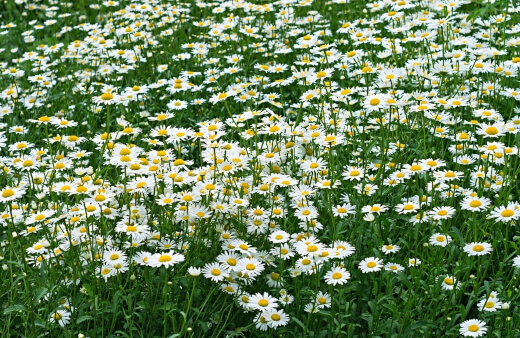
An aromatic alternative to grass, chamomile serves as a soft, lush ground cover perfect for sunny areas. Best suited for remote pieces of land with light foot traffic, chamomile lawns are low maintenance and beautifully-scented. Although it enjoys full sun, it will grow better in partial shade in areas that have a very high heat index.
It will need mowing once or twice a season to keep it looking like a neat lawn, or you can let it grow wild for a meadow-like effect. These plants prefer a well-drained light sandy or loam soil, and don’t do well in heavy clay soils.
The flowering variety produces small white and yellow flowers resembling daisies that you can use to make herbal tea, but some people prefer a non-flowering variety like Chamaemelum nobile ‘Treneague’ for lawns.
7. Australian Violet (Viola hederacea)
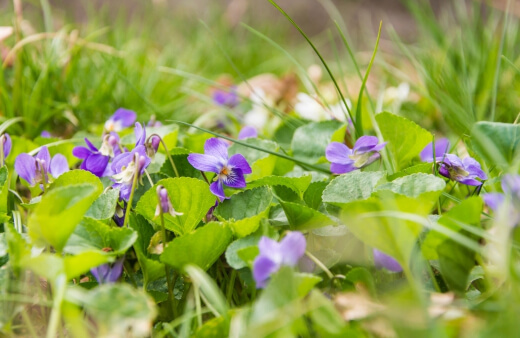
Recognized by its small but exceptionally pretty violet and white flowers, the Australian violet (Viola hederacea or Tasmanian Violet) is a stunning indigenous alternative to grass. It spreads underground as it grows, creating a thick and lush carpet that remains evergreen through the seasons.
Australian violet tolerates temperatures as high as the mid-40°C as long as it is watered, and can manage low temperatures around 5°C in the winter, although the plant may go dormant until it warms up.
It prefers damp conditions and grows well in shade or partial shade, is very hardy and provides the added benefit of edible flowers year-round in warmer locations. Because of its shade tolerance, you can grow it in areas where grass doesn’t thrive.
It will grow in sunny conditions as long as you keep the soil moist, but not waterlogged. You can plant it in almost any soil type, as it will grow in slightly acidic, neutral pH and slightly alkaline soils that are chalky, clay, loamy, or sandy.
Once established, it can tolerate moderate foot traffic, doesn’t need any mowing as it only grows to a 15cm height, and has a good frost tolerance and moderate drought tolerance.
8. Kidney Weed (Dichondra repens)
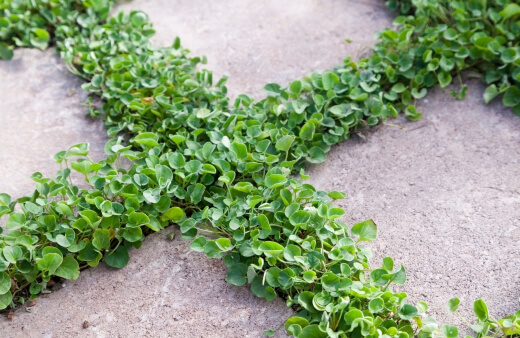
Despite being called a weed, Dichondra repens is a very effective lawn alternative that has a lot to offer. Native to Australia and New Zealand, it can be used instead of grass or as a soft buffer between stepping stones and requires little or no mowing because it is very low-growing.
These creeping plant is low maintenance, hardy, and feels luxurious underfoot. It grows best in partial shade and prefers light clay soils, although it still grows well in full sun.
It is a good choice for coastal gardens, tropical, moderate and cool temperate zones, and it tolerates light frost well. Kidney weed grows quickly, is playground and pet-friendly, and has a good level of drought-resistance.
It’s also very pest and disease resistant, and the thick carpet it creates helps prevent weed growth too, making gardening maintenance a little easier!
See our growing guide for Dichondra repens here. While you are at it, also see our guide on Dichondra argentea which may also pique your interest.
9. Rupturewort (Herniaria glabra)
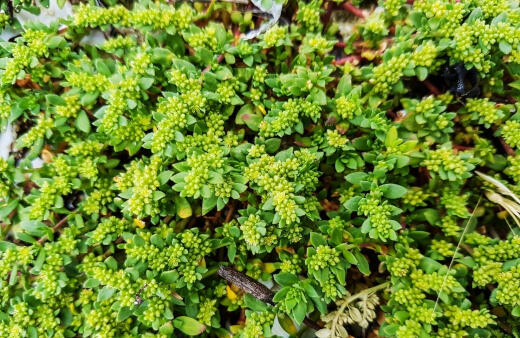
With its low stature, the Herniaria glabra plant came to be called “green carpet,” which makes it a perfect grass alternative. It grows well in any soil type, including gravel, and is able to manage heavy traffic easily, making it one of the toughest lawns that anyone can grow.
It’s ideal for families and pets, and despite it’s tough nature, is soft and cushion-like underfoot. The bright green foliage turns a bronze or red colour in winter months, transforming your garden though the season and creating an eye-catching visual effect.
It requires little in the way of fertiliser and only struggles in very boggy soil. Green carpet only grows about 2.5cm high, so it needs no mowing – ever – and although it produces very tiny white flowers, it doesn’t draw bees, making it safe for bare feet.
The only fault with this groundcover is that it is slow-growing, so it’s best to plant your lawn up well if you want an established lawn in a quick amount of time. On the positive side, this slow growth means it needs almost no maintenance.
10. White Clover

Requiring little maintenance and mowing, white clover seed ground cover replaces traditional grass easily in sunny, partial shade or full shade areas while being fairly drought resistant.
It’s native to northern Africa, Europe, the Middle-East and Western Asia, and is highly recommended for temperate zones in Australia and is a popular forage crop or cold season pasture option.
It doesn’t tend to do well in very hot or very dry climates, but grows well in fertile as well as non-fertile soil, as long as it isn’t waterlogged or too boggy. As a perennial legume, it is a great organic “living mulch” plant that suppresses weed growth and helps trap moisture.
It reduces nitrogen leaching from the soil and is often used in orchards and vegetable gardens as well as a lawn alternative. The flowers are a favourite for bees, which produce a high quality honey as a result (which is great if you want to try your hand at bee-keeping!), but you do have to be careful not to step on a stinger as a result.
White clover remains relatively short at 10-20 cm, so you can leave it to grow without mowing it to enjoy a meadow-like look, especially during the blooming season when you’ll see a carpet of gorgeous flowers in white and light pink. As an added benefit, clover ground cover does not need regular pesticide or herbicide treatments.
One important thing to be aware of if you are considering this lawn alternative is that white clover is considered an environmental weed in Victoria, New South Wales and Western Australia.
If you live in an environmentally-sensitive area or want to support the indigenous environment, you should plant a native alternative rather than white clover.
Here is our YouTube video showcasing lawn alternatives popular in Australia:
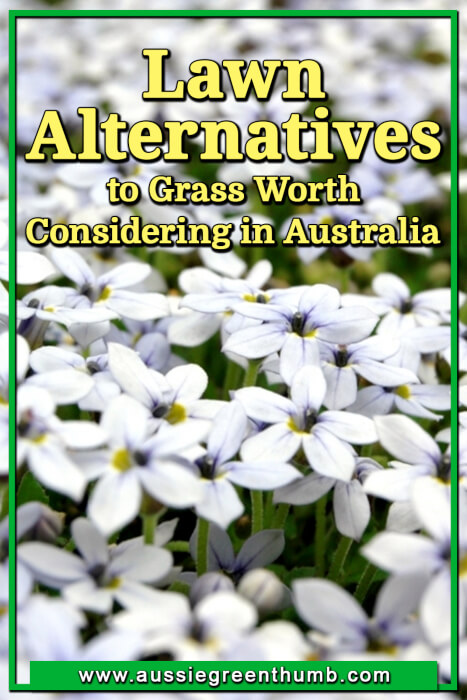
Explore Environmentally Friendly Lawn Alternatives
A gorgeous lawn doesn’t need to take hours every week to maintain, treat, and groom! Choosing a grass alternative, especially a native plant, is a wonderful way to add diversity and beauty to your garden without compromising functionality.
Many lawn alternatives can be used for cooking and bee-keeping, support beneficial insects and wildlife, and offer colour and flowers that traditional grass does not.
These lawns can help suppress weeds more effectively to reduce herbicide use, grow better in harsh or tricky conditions, and are more drought, heat and frost-resistant than traditional grasses.
Using these lawn alternatives mean less mowing, less fertiliser, less pesticide and less watering than ever before – and most importantly, you’re rewarded with chemical-free surroundings safe for children and pets.
Published on July 11, 2021 by Gary Clarke
Last Updated on September 26, 2024





Hi Gary, We are in Tasmania and are considering an Elfin Thyme lawn. Are seeds readily available, any suggestions?
Any advice gratefully received, Josh
Hi,
Thank you so much for your question! Elfin Thyme, or creeping thyme, is a great lawn alternative, since it is naturally drought-resistant, hardy, enjoys poor soil quality, and can withstand being walked on. It’s also very beautiful, with soft purple flowers and an aromatic scent.
The seeds are widely available online from suppliers, including:
• Boondie Seeds
• Australian Seed
• Herbs and Spices Australia
As you’re in Tasmania, we recommend using Australian Seed, as they ship to you and supply phytosanitary certificates, if required.
Make sure to let us know how your creeping thyme lawn project goes!
Cheers,
Gary Clarke
Hi, if we were to plant an alternative to grass, should we remove all the grass before hand? Or will the creeper eventually take over the grass?
Thanks, Sarah
Hi,
Thank you for your question! This really depends on your personal preference and whether you want to supplement your lawn grass or eventually only have your lawn alternative. There are pros and cons to both, as removing and replanting an entire lawn can be expensive and time-consuming, but you’ll be able to say goodbye to your old lawn grass for good.
Partial replacement is more affordable and easier to manage, but it does mean that you’ll be pulling out old grass for a long time to make sure your alternative has room to spread.
We personally recommend a completely fresh start. It’s more work, but lets you prepare the soil properly and create a good foundation for your lawn alternative to settle in and spread without being impeded. That way, your new lawn is properly managed and maintained right from the start, minimising ongoing maintenance.
I hope that answers your question!
The AGT Team
Hi. I am in the Darling Downs, Qld. and I'm being overrun by different grasses and weeds. It's an extensive area but I'm starting on the west and south of the house as that's where the dog roams. It's black soil and mostly full sun, and I have a dog with grass allergies. Could you tell please tell me which of the oregano, thyme or rupturewort would be best and how to go about starting?
Hi, I am interested in using native plants rather than a lawn in an area that was once a natural environment but has been trampled and driven on during house construction. I am in the Hunter Valley NSW, so is kangaroo grass accented with blue star creeper a good choice? What preparation of the soil is required before planting? The area is between the house and shed so will have a path or stepping stones. It gets full sun. My questions are endless, thanks so much Shay.
Hi Helena,
Thank you so much for your question! Tackling weeds and an overgrown lawn is no easy job, and we’re happy to give as much help as we can.
It sounds like you have an ideal garden for a lawn alternative, and we love all three that you are thinking about.
Our recommendation, based on your local environment and your furry one’s needs is that you may want to avoid the thyme or the oregano. They both tend to get a bit ragged and unhappy when it gets very wet and humid, and if they do well, then the beautiful flowers can attract bees, who your pup may not get on well with!
Rupturewort is a fantastic option for a lawn alternative because it is very low maintenance and requires no water other than rainfall once established. It might struggle in very wet weather and soggy soil, so it’s worth considering adding organic matter like bark chips or sand to your soil to make sure it drains well.
It also stands up well to traffic from people and animals, and although it has tiny flowers, they won’t attract bees. One of the best things about rupturewort, if you are unfamiliar with it, is the lovely, vanilla-like smell from the leaves, so although you won’t have the colour of thyme or oregano, you will have a year-round scent.
Some other alternatives that will do well in your area that are evergreen, easy to grow, and non-allergenic include dichondra repens (no mowing, likes sunshine and moist rich soil), Isotoma fluviatilis (blue flowers in summer, frost tolerant but drought sensitive), Alpine pratia or common pratia (blue or white flowers, growing in sun to shade in moist soil), and Corsican mint (beautiful scent, fast and flat growing, likes moisture, and thrives in sun).
All of these options require very little preparation from you, and most can be easily grown from seed, seedlings, or even cuttings from a larger plant (this is especially useful for growing rupturewort). Of course, you can always plant a mix of different options and see what does well. This can also create a very beautiful meadow look for your lawn.
Because you say your lawn is quite extensive, it may be a good idea to have a service come in and completely lift the turf to give the space a completely fresh start. This will take out all the unwanted weeds along with their seeds, which will otherwise come up year after year. Then you can go ahead and plant your seeds or cuttings in one go. But that’s completely up to you!
Once you have selected your lawn alternative and removed enough weeds to start establishing your new lawn, we recommend that you lightly dig over the surface, plant your seeds or cuttings, and water them well. Keep the soil moist for the first month or so while the plants become established and remove all emerging weeds regularly before they seed.
Then feed your new lawn with a light dose of organic fertiliser. If you are planting a native groundcover, be sure to use a low phosphorus fertiliser designed for native plants, as a higher dose of phosphorus can kill the plants.
Water this in well and keep up with weeding to prevent competition for food. After the plants are well-established, your lawn will need little to no maintenance apart from an occasional watering if it gets very dry.
All that hard work will pay off when you no longer need to weed, mow, feed, or maintain your lawn!
Let us know how your project goes!
Kind regards,
Gary Clarke
Hi Shay,
Thank you so much for your question! We absolutely love that you want to use native plants rather than lawn, so we’ll help out however we can.
In terms of the kangaroo grass, this is a pretty hardy and adaptable plant, so it should be happy in your local Mediterranean climate, especially with all the sun the space is getting. We’d recommend growing it from plantings, as the seed can take up to 12 months before springing to life.
If you do decide to go with seeds, we’d recommend sowing them anytime in the summer and sprinkling the ground with cool wood ash from your barbie, or sitting the seeds safely near the barbie. For native plants, the heat and smoke of a fire tends to break the dormancy of the seeds, and they should sprout a little faster, and the ash reinforces this and enriches the soil.
Blue star creeper should work very well with the kangaroo grass and make a beautiful contrast in your garden. Like the kangaroo grass, it’s very hardy and rewarding to grow, especially in a sunny spot, although it can tolerate light shade. The only thing it can’t handle is heavy traffic, so the stepping stones should be ideal.
In addition to ash, there’s not much else you need to do to prepare the soil for either plant. We’d recommend digging it up to relieve the compression in the soil and make it easier for roots to grow, and adding bark chips, wood chips or sand to clay soil to loosen it up.
Once established, this grass should be self-supporting – but before it gets there you should water it well for the first season to keep the soil moist and lay a layer of mulch over the area to help reduce evaporation and soil erosion.
If you feel your soil quality is very poor or you want to give the new plantings a boost, it’s worth it to use an organic native plant fertiliser (this is low in phosphorus) in spring and autumn, as long as you make it a light dose.
Let us know how your project goes!
Kind regards,
Gary
Hi there 🙂
I live in Blackheath and have killed off all my lawn, and I'm ready to replace it with something frost, snow & shade tolerant and that can withstand some foot traffic as I have veggie beds surrounding the lawn that get accessed regularly. Which ground covers would you suggest?
Thanks so much!
Hi Kate,
Thank you so much for your question! We love lawn alternatives and are happy to help out any way we can. Our team’s best suggestions for your local climate and garden needs include:
•Dichondra repens – This is a native Aussie creeper that has tiny, lily-pad-like leaves that are soft underfoot. Also called kidney weed, it grows in tight, dense formation, and doesn’t create the itchiness that grass does, making it an ideal lawn alternative.
It’s frost resistant (and stays green during winter), does well in semi shade and shade (although with more sun it grows more thickly), and it only grows about 100mm in height, so it doesn’t need any mowing.
•Microlaena stipioides – Also called weeping grass, this is a native grass that enjoys moist, shady conditions. It produces spikes of flowers through spring that reach about 20cm high on beautifully-arching stems, so it’s a good idea to let this grass grow long over the spring and mow it to a few cm high through the summer and winter, as it is a great wildlife attractor.
•Dianthus – This is a low-growing perennial with fine grey-green foliage and pink, mauve, or burgundy flowers (depending on the variety you choose). It is frost resistant, flowers through the summer (which may attract bees) and likes well-drained soil.
They’re best planted on sloping, sunny areas of the lawn or rockeries, and are best used if you want to turn your lawn into a meadow area.
•Scleranthus uniflorus – Also called knawel, this moss-like ground cover is a tough, slow-growing lawn alternative native to alpine regions of Australia, New Zealand and South America. You can easily grow it from cuttings, seed, or by dividing existing plants.
It is low growing, frost tolerant, and soft under foot. It gets tiny yellow flowers in late summer, is drought tolerant, and remains evergreen.
•Chamomile – Creeping varieties of chamomile make a great addition to a lawn, forming a soft mat for medium traffic, with apple-scented green foliage and pretty white and gold daisy flowers through the summer. It will grow well in sun or shade, is frost tolerant, and likes moist, free-draining soil. If you do choose this for your lawn, remember to leave it for the flowering season and cut back hard at the end of summer.
•Pratia angulate – Also known as white stars, this is a tough, mat-like groundcover native to New Zealand. It is a great no-mow lawn alternative as it grows just 10cm tall and it thrives in sun to partial shade conditions.
It will tolerate moderate traffic and has pretty white flowers in the spring and summer.
Let us know how your project goes!
Kind regards,
Gary Clarke
Hi
I have a female British bulldog who is destroying my lawn. Thus, reading your website I thought I may try kidney weed. I also have a 96 year old mum who lives with me so I’m looking for a cover which will be safe for her. Is not get her feet caught up in the cover and fall.
Will this be a good alternative and meet my needs? I thought I would try a small area about 4m x 4m before putting it in other areas.
Where would I purchase the kidney weed? How much would I need for that smaller area? And what would the cost be?
Any guidance would be appreciated
Regards
Jenny
Hi Jenny,
Thanks for sending in your question! Kidney weed, or dichondra repens, is a fantastic lawn alternative because it manages temperature, sunlight, and low temperatures well, needs no mowing, and thrives in the sun and in the shade. It also grows quite quickly in the spring, summer, and autumn, so it should establish itself well in no time at all.
Based on your situation, we think kidney weed will work well. There’s nothing that will stop a determined bulldog, but kidney weed is not as tasty to dogs as grass is, so this should help a lot.
You can grow it either from seed or from small seedlings, with the seeds needing to be planted in cooler weather and taking around 7-21 days to sprout. In terms of coverage, 1kg of seed will cover 100 square metres, so you won’t need more than 40g of seed for your 4×4 metre space.
If you do choose seeds, remember to dig over the piece of lawn well and gently water the soil and seeds each day to keep the ground moist. The price of the seeds will depend on where you buy them, but they are very affordable and widely available.
Seedlings will cost a little more to buy, but again you can find them at a lot of nurseries for a good price. Kidney weed spreads very well (up to 1 metre per plant!), so you wouldn’t need too many to fill a 4×4 metre area.
We’d recommend planting seedlings about 25 cm apart, so you would need around 12 seedlings for that space.
We hope this helped you out!
Kind regards,
Gary Clarke
Hello Gary,
I planted a thyme lawn in May 2020 and in certain areas it has done very well. However, there are bare patches where the sun hits and the thyme refuses to grow even in the cooler months. I am thinking of planting dichondria in those areas and having a mixed lawn. Does this sound like a good plan?
Secondly, creeping oxalis has invaded areas of the thyme lawn and I believe that thyme is very sensitive to sprays. Unfortunately I have been incapacitated through all of spring and the garden has got away on me!
There is another issue – we had the garden landscaped last year with the soil being replaced and we have now what I think is onion weed and garlic weed which has spread throughout large areas of the garden and lawn.
If you have any suggestions for any of these issues, I would be most grateful.
Thank you for help.
Margrett
PS: We live in regional Victoria – 3 hours southeast of Melbourne.
Hi Margrett,
A Thyme lawn is always a great idea, but it can become a challenge sometimes. Ideally, your thyme lawn should be getting around 4 hours of sunlight per day. Patches that receive more can dry out and turn brown.
Regularly mulching can perhaps help this issue. It is a good idea to add some dichondra into the mix as it will add to your textured lawn and will thrive in full sun and part shade. It will need warm soil conditions to germinate.
Between October and December is actually the best time to sow seeds. However, it may take as long 12 months to become established. Dealing with creeping oxtails can be tricky. As you say, you won’t want to use any harsh chemicals that can affect your lawn.
If you can, attempt to remove as many as possible by hand. Use a spade to dig them up before they flower and form seeds. Be sure to remove all parts of the plant, roots and rhizomes too. Another option is to apply a vinegar solution or baking soda solution to the weeds.
Try to wait for a day with no wind or rain, so it won’t spread to your other plants. Onion and garlic weed can also be a challenge to maintain, especially as they are so hard to pull out by hand. For smaller areas, you can use a Lawn Weed Killer concentrate.
You can consider digging out the individual bulbs- but this may damage your lawn. Using vinegar is also an option. Steam when used repeatedly can also eventually kill off the weed.
Kind Regards,
Gary Clarke
Hello,
I’m looking for a native alternative for my riding arena. It’s well drained (top of the hill) but heavy clay/volcanic soil. We are central Victoria, get snow about once a year, and a short growing season due to frosts and cold winds, the site is full sun. I’m after something preferably edible, and springy underfoot.
Thanks Kate.
Hello can you tell me how to prepare the soil for dichondra repens please?
Hi Kate,
Growing grasses in clay soil can be incredibly tricky. As your region experiences a colder winter, it’s a great idea to consider Weeping Grass or Wallaby grass. These types of natives will do well in a colder growing season. If you’re looking for something more edible, consider Elfin Thyme or Red Creeping thyme.
These are a great option to give you the underfoot feel you’re looking for. If you’re willing to consider something which is not an Aussie native, you can also consider Tall Fescue. It grows vigorous in colder months, bunches well and thrives in shade or full sun. It is, however, slightly high-maintenance.
Best Regards,
Gary Clarke
Really interesting post!
Hi there Pauline,
Dichondra Repens normally prefers sandy soil types in order to grow and thrive. Overall, the soil should be loose and well-draining. A sandy loam soil with a neutral pH level should be perfect for your Dichondra.
If you are looking at using clay-based soil, then consider planting in a raised garden bed as clay soil often stays wet for too long after watering. This will help the soil drain itself more effectively.
Furthermore, if you are interested in using fertiliser in your soil, a fertiliser with high nitrogen levels should work great. To help the soil breathe and drain well you can also add some perlite or rough organic matter like bark or mulch to the soil.
Best regards,
Gary Clarke
Hi Gary,
As one half of a couple who 1. Hates mowing the lawn and 2. Thinks grass is a colossal waste of space, energy and resources – I love this post so much! I'm wondering whether it's possible to have a mix of several different types of ground cover mentioned in your post and just letting them do their thing, or is it best to stick to one option and have it cover the whole space?
Thanks for this article, it's really opened my eyes to the possibilities!
Jorja
Hi Gary, based on your lawn alternatives article I was curious to know if creeping thyme and/or green carpet rupturewort would work for our small garden in Perth that gets a lot of foot traffic from the dog and the kid. Can you mix the two and if so, do you just plant seeds together randomly or what do you recommend? How long do both of them take to grow from seeds? Where can you buy seeds or plants from in Perth and could you do some plants so it's not bare everywhere and wait for the rest of the seeds to grow in (to save costs on all plants)? All advice welcome on ripping up a regular lawn and replanting with native lawn alternatives in Perth welcome. Thanks!
Hi there Saskia,
Thank you for your questions.
I’m going to try to answer each of them in as much detail as possible.
Firstly, both creeping thyme and green carpet rupturewort will make for excellent lawn alternatives for your garden and conditions in Perth. Creeping thyme tolerates modest foot traffic and will attract bees so this will need to be considered for your kid and dog.
It spreads fast and will also choke out any weeds in your landscape. It won’t require much mowing other than to keep its shape and neatness.On the other hand, green carpet can grow in most soil types and tolerates heavy foot traffic.
It is known as one of the toughest lawn alternatives and it is easy to grow and doesn’t require much mowing if any. Green carpet is ideal for families with pets and kids as it offers a superior soft cushion-like feel underfoot and doesn’t attract bees so it’s safe for barefoot play in the garden.
The only caveat to green carpet is that it is slow-growing compared to creeping thyme. When it comes to mixing the two in your landscape, I don’t know too much about this and haven’t heard of anyone that has attempted this. But, I’m sure it’s possible.
Some may say it’s safer to choose one as they each offer their own growing speeds, feel and colour variations. For a more consistent-looking lawn overall, it may be better to go with one rather than combining them. But if you do attempt it, please be sure to let us know how it turns out.
For the planting of the seeds, if you do choose to mix the two, I would recommend planting in such a way that will give you the look you’re after. You can mix them randomly for a more textured and playful appearance or you can space them with more intention for a cleaner, more orthodox appearance once established.
It ultimately will come down to your family’s preference. If you choose to sow only one type, it is usually recommended for lawns to scatter the seeds across the desired site and press the seeds firmly into the soil. On average, you will need roughly 5000 seeds per 10 metres squared for lawns and groundcover.
Alternatively, you can plant 2 to 3 seeds about 30 to 40 centimetres apart in staggered rows. Plant your seeds no deeper than about 2mm. Water well after sowing to prevent the wind from disturbing the newly planted seeds and keep the soil consistently moist while the seedlings develop.
You can cut back on watering once they are established. Creeping thyme normally takes one year to get fully established whereas green carpet may take up to 2 years to reach full maturity being a slower growing species. Green carpet also takes about 3 to 4 months to start looking less patchy.
When it comes to acquiring your seeds or starter plants in Perth, it seems that Bunnings Belmont WA and Bunnings East Victoria Park both mention that they stock seeds and young plants for both creeping thyme and green carpet on their websites.
Alternatively, you can always try to reach out to your local professionals at your nearby nurseries or garden centres for more information.
For a few plant recommendations to help fill the space while your lawn establishes itself, it is important to first consider what your garden design goals are, what are you aiming to achieve in terms of functionality within your landscape and finally, how much sunlight does the area receive.
Here are a few plant recommendations for you:
If you wish to establish any of these plants faster, I would recommend planting young starter plants that will reach maturity faster, meaning you can fill up the space in your landscape with more speed while you wait for your lawn to establish itself.
For advice on removing existing lawn and laying new turf, we have an informative in-depth article that will help you which I will link below for your perusal.
How to Lay Turf – A Step by Step Guide to Turfing Your Backyard
I hope this information helps you. We wish you all the best of luck creating your new outdoor sanctuary.
Happy gardening from the team at AGT!
Hi there Jorja,
I’m glad you enjoyed the article and found some useful information!
With regards to your question, I’ve mentioned to another fellow grower before that I’m sure mixing different species and ground cover is possible, I just haven’t attempted it myself nor have I heard of someone else giving it a go.
My opinion is that it largely depends on your needs, creative landscaping desires and the overall aesthetic you’re going for with your lawn. Say may say it’s better to plant only one type as each species could have different growth rates, feel and colour variations, meaning there will naturally be some inconsistencies if you choose to mix.
For a more consistent-looking and feeling lawn, it might be better to choose one alternative and go with that. On the other hand, I couldn’t imagine that mixing some of the species mentioned in the post would turn out badly.
If you do choose to mix, I would recommend choosing only two ground covers rather than adding more variation. You’ll still want to keep maintenance like mowing, fertilising and watering routines relatively the same across the lawn for convenience.
I hope this helped. Ultimately, it’s about you and your family having fun and enjoying your lawn. Whatever that means to you, it should be possible. Please let us know how things turn out should you choose to mix your lawn.
Happy gardening!
Gary Clarke
Hi AGT team,
A few years ago I tried my hand at growing a dichondra repens lawn at the front of my house.
I like the idea of having a green lawn all year round, lush low maintenance and good for the environment.
It hasn’t unfortunately ended well – the weeds have taken over!
I live in Victoria, and the front yard slopes down facing south east with a clay like soil.
I got the bobcat in, dug up a good 15cm and replaced the topsoil before we got started. I got a ridiculous number of seedlings, which i planted at about 20cm intervals, and seeded in between.
The weeds started popping up in between before the dichondra could spread, even in the centre of some of them, but I spent hundreds of hours over the next couple years trying to get rid of them manually (recommend a weed killer that won’t kill dichondra?) then I got pregnant, and was too tired and busy to get out there much, and bindis, clover, and many kinds of tap rooted weed as well as grasses have just about smothered the dichondra.
The only place it’s still visible is in between the timber paver path I laid down.
Now that my son is toddling around and more independent, i’d like to give the lawn another shot, but I really don’t want to go to the expense of digging the lot up again – pretty sure my neighbors already think I’m crazy!
I’m currently working on getting rid of the weeds again manually, but I’ve filled the green bin twice over and there’s still many more to go.
I think this time around I’d like to go with a more varied approach – a meadow look that’s soft underfoot but maybe has a few more varieties to thrive and smother those weeds – what would you suggest?
I have progress photos and current photos if they would help!
Hi Stacey,
It’s the same with almost any experimental lawn, weeds will fight back. Grass-based lawns suppress weeds so well for two reasons: They are heavy nitrogen feeders, so take a lot of goodness out of the soil, but they are also cut regularly, which deadheads weeds before they set seed, and prevents perennial weeds from photosynthesizing.
Because Dichondra repens takes a while to establish from plugs, or from seed, it will take a few years for it to have any real impact as a weed suppressing mulch.
The only way to rectify the Dichondra lawn would be to keep deadheading annual weeds, and pulling perennial ones, but bindis are really difficult to get rid of without inorganic controls.
There are three organic options that I’d suggest:
The first is to change the main lawn plant to something more voracious like mind your own business (Soleirolia soleirolii) which has a similar look to Dichondra, but spreads faster, and takes up more nutrients.
It will also completely smother anything that tries to grow through it. You’ll need to edge it a couple of times a year to keep it in control, but it’s not as hard to maintain as other lawn alternatives.
The other option is lawn chamomile, which is low-growing but grows taller than bindis, so acts as a mulch pretty quickly. It’s slow spreading, but you can buy plugs pretty cheaply online. It’s also got the added advantage of smelling divine.
Now… The nuclear option is to go all out as you mentioned with a meadow look!
The clover would suit a natural meadow and will be encouraged to grow taller, with fluffier flower spikes, and throwing calendulas, poppies, meadowsweet, and honesty around, you’ll get a beautiful winter structure too, which wildlife will love. The downside of meadows is that they look pretty rough in winter.
Good luck, and hopefully send us pictures when you’re done! We’d love to see the progress.
Gary Clarke
Hi Gary. Fantastic article, thankyou.
We are in Brisbane eastern suburbs and looking for the best ground cover for two different areas.
The first is a 8 x 15m sloped area on eastern side, mostly full sun but shaded in parts. It is red clay soil. Grass doesn't grow particularly well.
The second is a 2m x 10m area on southern side, mostly shaded with little sun, weeds grow but not grass!
Need something that will be child friendly and cope with moderately heavy foot traffic. Would prefer it not to look 'weedy' as rest of garden is fairly formal.
Hi Liz,
It’ll need to be tough thanks to the kids, as well as the slope, and if it’s going to have or fit into a formal garden then that counts out most lawn alternatives, leaving you with basically two choices.
The first is clover, which will form a tight mat of gorgeous foliage, as well as manageable pollen-rich flowers which flower evenly across your whole lawn at once – making an evenly dappled effect, rather than patchy flowers. It will also root well into the slope, and can cope well with the enhanced drainage in those conditions.
The second, and my personal choice (but it’s not for everyone) is lawn chamomile. You can literally mow it to keep it looking neat, the cent is outstanding, and when it flowers in summer you’ll have a beautiful but manageable meadow that can be cut back as soon as the flowers begin to fade. If you prefer to keep it green, just cut it back when it gets taller than 4cm.
If putting up with heavy foot traffic is the most important factor, then go for clover. If it’s beauty, formality and seasonal interest within traditional formal design, then go for lawn chamomile. Both offer something unique though, and should work well in that sort of setting, even with a really hot summer.
Best regards,
Gary Clarke
Hi,
I am writing from Canada. My elderly in-laws live in Joondalup about 4 blocks from the beach. They have sandy soil but it is automatically watered twice a week so can (barely) sustain a lawn.
Recently the majority of the front lawn has died off and I was wondering if there is a grass alternative that I can send them and they can re-seed with before it warms up again. They are in their 80's and barely mobile. A neighbor mows their lawn for them and probably the most they could do is scatter the seed and hope for the best.
In Canada, micro clover and white clover are very popular as it is low maintenance, drought tolerant, green, and helps build up the soil. If scattered during the wet season here it will seed itself.
Do you have anything like our Clover that will work in Perth for my in-laws?
Thank you for your time,
Gary Faryon
Vancouver BC
Hi Gary,
White clover would almost certainly work. It’s a tough plant and it’s native to Australia (as well as most of the rest of the world). The other options that would definitely work, would be creeping thyme.
It’ll take slightly longer to establish, so won’t look great this year, but can be cut like lawn, and trodden on. Plus, it’s pretty much ideal for that sort of climate and exposure.
Clover or creeping thyme would come up nicely in those conditions, but if you’re wanting to seed into the existing lawn, without taking it up, I’d stick to the basics and go with white clover.
Best regards,
Gary Clarke
How does one spot the snakes? We have dugites and the occasional tiger snake, both deadly.
Hey Rick,
Thanks, that’s a great question. I don’t have any method but when I am starting my gardening I purposefully be noisy and try to vibrate the ground by putting my tools down with force or bang the shovel on the ground.
I have red-bellied black snakes, brown snakes and tiger snakes around. I normally don’t see them until we’re quite close and I normally get a bit of a fright and then slowly move away.
As I said, no real method for spotting them, just being aware helps I think.
Does anyone else have any suggestions for spotting snakes in the yard and garden?
Nathan Schwartz
Hi I live on Kangaroo island now an aged pensioner I’m looking to make my front garden easy for me to look after I want to either an plant non invasive lawn of a green alternative eg Dicondra repens what would you suggest
Thankyou so much in advance ?
Hi Laura,
Dichondra is always the go to, but it is still potentially invasive, so if you’re looking for a low-maintenance option (i.e. One that doesn’t need weeding all the time) I’d go for chamomile or clover.
Chamomile is one of the easiest, because you can cut it hard a few times a year. My neighbour has a small patch next to their patio before you get to their main lawn, and they just mow it with the blades set as high as possible.
White clover works in the same sort of way, and when you remove the competition by digging out the grass entirely, it stays low and, like chamomile, can be mown a couple of times a year.
The negative of clover is that it will self-seed. It doesn’t spread as quickly as dichondra, but pops up where you least expect it.
Chamomile, which also self-seeds, is a bit of a miracle plant, because in lawns, when cut it remains low growing, with occasional flowers, but if it seeds into your borders you get a gorgeous, prolifically flowered daisy.
Both grow well around Adelaide, so I’m sure you’d have success on Kangaroo Island.
Best regards,
Gary Clarke